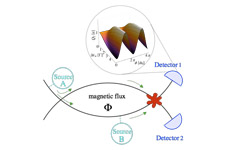Single-particle interference versus two-particle collisions (Vol. 43 No. 3)
 Electronic interferometer fed by two independent single-particle sources. The magnetic field dependent interference, as a function of the phase difference Φ, in the transmitted charge Q2 is found to be suppressed with the occurrence of particle collisions at time difference Δtu=0.
Electronic interferometer fed by two independent single-particle sources. The magnetic field dependent interference, as a function of the phase difference Φ, in the transmitted charge Q2 is found to be suppressed with the occurrence of particle collisions at time difference Δtu=0.
The recent experimental realization of an on-demand coherent single-electron source [G. Fève et al., Science (2007)] allows exploiting the individual particles' quantum nature in controlled single- and multi-particle effects in solid-state devices. In particular, it inspires to perform interference studies in electronic interferometers into which well-separated single particles - electrons or holes - are injected.
Stimulated by these possibilities, this article proposes a setup where the single-particle interference in an electronic interferometer is influenced by the presence of a second particle-emitting source placed in one of the interferometer arms. The two sources can be synchronized with respect to each other creating tunable and coherent modulation, and even suppression, of interference. Importantly, this study envisions and theoretically analyzes an experimental setup, in which both aspects of the quantum nature of electrons can be observed simultaneously: its wave-like and its particle-like behaviour. The time-dependent current shows an interference pattern, to which the second source adds a peculiar time-dependent phase determined by its working mode: this intriguing interference effect is convincingly explained by the particles' wave-like behaviour. Yet at the same time, a tunable coherent suppression of the interference is expected in the total transmitted charge, which is shown to be a feature of the particles' ability to collide. The coexistence of the two effects leading to interference suppression in the absence of dephasing is a fascinating challenge for our understanding of quantum mechanics.
Single-particle interference versus two-particle collisions
S. Juergens, J. Splettstoesser and M. Moskalets, EPL, 96, 37011 (2011)
[Abstract]







